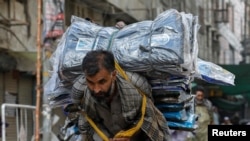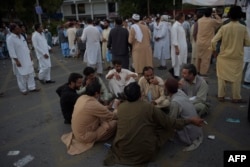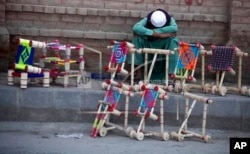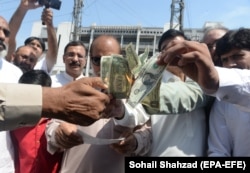In 2017, China poured billions of dollars into energy and infrastructure investments into Pakistan and the World Bank praised Islamabad for accelerating gross domestic product growth, which exceeded 5 percent that fiscal year -- the highest in nearly a decade.
But after the country’s top court sacked the business-savvy Prime Minister Nawaz Sharif in July of that same year, Pakistan’s military publicly criticized his administration, led by his Pakistan Muslim League Nawaz (PML-N) party, for its handling of the economy.
“The economy is showing mixed indicators,” army chief General Qamar Javed Bajwa told business leaders in October 2017. “Growth has picked up, but the debts are sky-high. Infrastructure and energy [sectors] have improved considerably but the current account balance is not in our favor.”
Four years later, the administration of Prime Minister Imran Khan -- which the PML-N and other opposition groups allege was propelled into power after the military rigged the 2018 election in its favor -- is looking at the slowest growth rate in South Asia as more that 220 million Pakistanis struggle with runaway food inflation and rising unemployment. After the country recorded negative growth for the first time since 1952 last year, Beijing’s enthusiasm for turning around Islamabad’s economic fortunes appears to have cooled down, too.
In Islamabad, most of the economic talk oscillates between despair and jubilation. Shaukat Tarin, Khan’s finance minister, the fourth in less than three years, warned lawmakers this month that if their administration fails to return GDP growth to 5 percent Pakistan will be at "God’s mercy for the next four years.”
He also lamented tough International Monetary Fund (IMF) conditionalities that require Islamabad to increase revenue by raising taxes and adopting austerity by cutting subsidies -- both of which economists say contribute to runaway inflation. Since 2019, Pakistan has followed a $6 billion IMF loan program that requires it to increase tax collection through reforms while adopting measures to bridge the budget deficit.
“Our people are really sick of rising inflation," Tarin said. "At this moment, we don't have the capacity to increase tariffs or taxes.”
Last week, however, the government reported a higher-than-expected economic growth rate. “National Accounts Committee has finalized GDP growth estimate & GDP growth is estimated at 3.94 percent,” Prime Minister Imran Khan tweeted on May 21. “This reflects the success of our govt's economic policies while managing COVID 19 pandemic,” he added. “Our V-shaped recovery is balanced between 3 major sectors: agriculture, industry & services.”
Khan’s cabinet members were falling over one another to claim victory. "This growth in a period in which COVID placed a huge challenge to the economy is extremely gratifying," Planning Minister Asad Umar tweeted.
“This is a remarkable recovery & unlike past growth stints, forex reserves have also grown and the current account remains in surplus,” Energy Minister Hammad Azhar wrote. “Industry led this growth.”
A Litany Of Missteps
Across Pakistan, many questioned such an optimistic economic outlook that doesn’t match the reality of their hardship. Independent economists and opposition politicians say the latest projections actually follow a very low base from last year and the government’s celebrations are premature. There’s an uphill struggle ahead for Islamabad, they maintain, with real wages stagnant or declining amid sky-high inflation, rising poverty, mounting debt, and rising unemployment.
“The specter of high inflation and low GDP growth is a very problematic scenario for Pakistan,” says Ali Nadir, a private equity and investments specialist. “This is not going to be an easy ship to turn.”
Nadir argues that the government’s accountability drive, which largely targeted opposition politicians for alleged corruption, only served to scare the business community and send the country’s vast civil bureaucracy into shutdown mode. The administration’s lack of a clear economic vision beyond joining the IMF program in 2019 only made matters worse.
“The structural adjustment policy followed under the IMF aegis was contractionary and low growth and put the economy on a path to very slow growth, high interest rates, and increasing unemployment,” Nadir told Gandhara. The World Bank has projected 1.3 percent GDP growth for 2020-2021 while the IMF’s estimate is slightly higher at 1.5 percent.
“The only area where things are better is the external account, where the reduction in imports and the increase in remittances [have] improved the situation somewhat,” Nadir said. “But the fiscal position is very poor with an unmanageable increase in debts.”
Miftah Ismail, an industrialist and economist, served as an adviser and finance minister in PMLN’s cabinet in 2018. He says Khan’s administration moved fast on hiking interest rates from over 6 percent to more than 13 percent after assuming office in August 2018 as the Pakistani rupee rapidly devalued more than 25 percent against the dollar.
“With the rise of interest rates, the economy slowed down. With the devaluation, inflation came in,” he told Gandhara. “When inflation is rising and employment shrinks, of course you have poverty.”
Government and international statistics show poverty among Pakistan’s rapidly expanding estimated 220 million population is on the rise. International lenders expect poverty to rise to more than 40 percent from 24 percent in 2015, and the country could be home to as many as 80 million poor compared to some 55 million in 2015.
“With shrinking GDP, employment has also shrunk considerably,” Ismail noted. “In a country where 1.8 million people join the labor market every year, you need growth of at least 5.5 percent to 6 percent to absorb all the growth.”
Structural Problems
Ali Malik, a financial adviser and writer in the eastern city of Lahore, says that while the current government’s initial indecision contributed to “stagflation” marked by no growth and rising inflation, his country’s economic troubles are much deeper and need to be analyzed without partisan bias.
“The problem is that none of the governments had the vision to focus on increasing the real wealth of the nation,” he told Gandhara. “You have to understand that till today, Pakistan is a very agriculture-driven country where the real wealth comes from the agricultural sector, which earns the country most of its wealth, especially foreign currency.”
Malik says a bumper wheat crop and rising agricultural commodity prices on international markets contributed to the revised growth figures Islamabad is now brandishing as a success. “There is no sustainable mechanism to beef up the agricultural sector,” he said. “As long as the government doesn’t do it, [the current upturn] probably will remain short-lived.”
He argues that successive governments have ignored agriculture and instead focused on rising domestic growth by building infrastructure financed by mounting debts. The real estate sector was touted as the major money-making sector.
“This ultimately leads to a lot of parking of capital in a virtually dead productive sector,” he said. “This has been a pattern in Pakistan during the last few decades with very few exceptions that most of the capital is allocated to sectors that are nonproductive.”
Uzair Younus, a senior policy analyst at Washington’s United States Institute of Peace think tank, agrees with Malik’s prognosis that Pakistan’s economy suffers from structural vulnerabilities. He says the revised growth figures are a positive sign of a nascent recovery taking hold. “However, the growth is coming on the back of significant fiscal and monetary support, particularly to the real estate sector,” he noted. “This creates the risk of incentivizing too [many] resources in a sector that doesn’t build Pakistan’s long-term productivity and export capacity.”
Younus says successive governments have typically overvalued the exchange rate as a way to subsidize consumption. This, he argues, makes exports cheaper and prompts consumption-led spending, which is further accentuated by larger spending on public-sector development programs -- a formula some previous administrations followed.
“At some point, you have to pay back that money,” Younus said. “If your currency is overvalued, your exporters are losing out with the rest of the world meaning that your imbalances in the current account continue to grow,” he added. “It’s like a pressure cooker -- the pressure keeps on building and eventually it blows up.”
Younus, who frequently blogs and hosts a podcast on Pakistan’s economy, says such cycles typically drive Pakistan’s economic crises.
“Most Pakistanis will argue that it is a boom-bust cycle,” he said. “But for a boom to qualify as a boom, it has to last longer than a couple of years.”
“If you go back and look at the growth data, Pakistan’s economy looks like one of a patient who is having a heart attack,” he added. “The growth rate will collapse and go over 4 percent, but the moment it goes over 4 percent it will collapse again simply because the growth model pursued by Pakistani policymakers is unsustainable.”
Pakistan’s high defense spending, which goes well over global-average 2 percent of GDP, comprises some 20 percent of overall government expenditure and constantly overshadows the economy. Despite the onset of the COVID pandemic last year, Islamabad increased its defense budget 11 percent to $7.85 billion compared to a paltry $151 million for health care.
“This leaves limited space for the government to use fiscal resources on development,” Younus said, although he added that Pakistan has battled an insurgency in recent years, which upped the military bill. “Without internal security, the economy cannot move forward, either.”
Toward Prosperity
In March, Bangladesh celebrated 50 years of independence from Pakistan. Dhaka was once Islamabad’s impoverished eastern half that lost most of its gains in a brief brutal separatist war in 1971. But today it is well ahead of Pakistan in key economic indicators. Its $1,855 GDP per capita in 2019 was a third more than Pakistan’s $1,284 as the two countries follow vastly different trajectories of growth and human development.
Economists see few silver linings in an overall bleak economic outlook for Pakistan. Malik says a policy shift fixing the wrong allocation of capital could be a way out.
“The focus has to be on enhancing the agriculture sector and formalizing the country’s mining sector because these are the two real wealth generators in the country,” he said. “Then gradually encouraging industries, starting from the low skilled ones, to develop.”
He says a new policy approach must discourage parking capital in real estate. “They have to find creative mechanisms to figure out how can they taper the real estate sector without a bubble burst,” he noted.
Younus also sees potential in Pakistan’s industrial and agricultural base, as well as in its young population. “There are good green shoots in the ground, particularly in the technology and startup sector, which is thriving, and the government has so far played a role in ensuring that,” he said.
He warns though of political instability overshadowing the quest for economic prosperity. “So long as the political game of thrones continues, governments will find it difficult to pursue these reforms,” he said. “So long as those in power [do] not lose out because of successive IMF programs [and] are not impacted by sky-high food inflation, there is not a lot of incentive to pursue reforms.”
In Islamabad, government officials are celebrating the latest economic figures and promising a growth-oriented budget. But a split within the ruling party looms large over the fate of the Khan administration, which clings to power with only a razor-thin majority in the parliament.


















